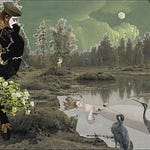XIV. PIERROT VOLEUR
Les rouges rubis souverains, Injectés de meurtre et de gloire, Sommeillent au creux d’une armoire Dans l’horreur des longs souterrains.
Pierrot, avec des malandrins, Veut ravir un jour, après boire, Les rouges rubis souverains Injectés de meurtre et de gloire.
Mais la peur hérisse leurs crins : Parmi le velours et la moire, Comme des yeux dans l’ombre noire, S’enflamment du fond des écrins Les rouges rubis souverains !
XIV. PIERROT, THIEF
The most excellent red rubies, embalmed with murder and glory, sleep in a cabinet’s cavity in the horror of long deep tunnels.
Pierrot, with some highway robbers, decides, after drinking one day, to steal the most excellent red rubies, embalmed with murder and glory.
But fear sets their hair on end: Amidst the velour and the mohair, Like eyes in the black shadows, Burn in the bottom of the jewel-box The most excellent red rubies!
NOTES.
2 souverain : Of the highest quality.
3 injectés : From its first DAf appearance in 1762, the principle denotation of the verb injecter has been the procedure of using some instrument to inject some fluid into some part of a patient’s body for some medical purpose; the range of possible instruments, liquids, body parts, and medical purposes has slowly expanded since. DAf1835 introduced a secondary denotation, in which the body is a cadaver, the body parts are its blood vessels, the liquid is a dye (or mercury), and the purpose is anatomical rather than medical—either to preserve the body or to guide and facilitate its dissection; in particular, « Cadavre injecté » denoted a body embalm- ed in just that manner. DAf1878 adds (and DAf1935 labels explicitly as figurative) a few idioms: « Face injectée, Face colorée par l’afflux du sang. Yeux injectés de sang, ou simplement, Yeux injectés, Yeux où l’engorgement du sang fait paraître de petites veines rouges », ‘Injected face, Face colored by a rush of blood. Eyes injected with blood, or simply, Injected eyes, Eyes where a surplus of blood causes little red veins to appear’. Apparently Giraud’s rubies, embalmed with murder and glory, burn in the black shadow like specifically bloodshot eyes.
gloire : Perhaps simply ‘glory’; but perhaps (particularly in light of the image at the end of the third stanza) also alluding to the painterly meanings having to do with light (XII.6, XIX.12)
5 souterrain : Tunnel; more specifically, « Lieu voûté, pratiqué sous terre et ordi- nairement sous le rez-de-chaussée d’un édifice », ‘A vaulted space, dug under- ground and ordinarily below the street level of a building’.
6 malandrins : Literally, highway robbers; according to Picoche, a 14th century bor- rowing from Italian malandrino (with the same meaning), composed from Italian malo, ‘bad’, and Middle German landern, ‘to wander about, to be a vagabond’. (See also Flemish lenteren, ‘to walk around idly’, Scheler1865 as in XLIV.1). DAf1878, the first edition to include the word, has an example sentence that incidentally reports a useful fact: « On appelait malandrins, au quatorzième siècle, des bandes de pillards qui infestaient la France », ‘Malandrins was the name for bands of looters that used to infest France in the 14th century’. The malandrins here were quite possibly some of Pierrot’s fellow actors.
10 hérisse leurs crins : DAf1935: [NOTE UNDER CONSTRUCTION] the device (what?) came first, then it was nicknamed for the Frisians who used it, then the breed of horse was named for THEM, then the hedgehog, and finally the verb arrived!] (doublecheck) [crin is a coarse hair like those in a horse’s mane or tail] [hérisser is to bristle like a hedgehog ; hérisson is a hedgehog ; only the current edition of DAf gives an etymology, to wit, « xiie siècle, hericer. Issu du latin populaire *ericiare, dérivé du latin classique hericius, hérisson ; chevaux de frise ».
11 moire : See XII.13.
13 écrins : Plural. From Latin scrīnium, specifically a circular box of indeterminate size for general storage; adopted into French by the 12th century, with the meaning (since at least the 17th century) of a small box of indeterminate shape for storing jewelry in particular. Semantic drift can be weird and wonderful.











Share this post